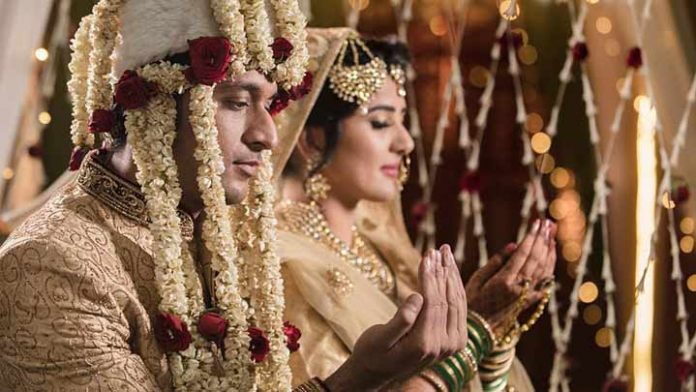This article is written by Oishika Banerji from Amity Law School, Kolkata. This article deals with the validity of the marriage under Section 5 of the Hindu Marriage Act, 1955.
Table of Contents
Introduction
The Hindu Marriage Act of 1955 is a codified law governing Hindu marriages. On becoming a codified law on 18th May 1955, the Hindu Marriage Act, 1955 became applicable for all Hindus, Buddhists, Jains, or Sikhs. The Act is also felicitous to all persons who are not by religion Muslims, Christians, Parsis, or Jews as having been provided by Section 2 (1) (c) of the Act. This article aims to provide a deep understanding of Section 5 of the Act which deals with the conditions for a Hindu marriage that are required to be fulfilled to consider the marriage as valid. Along with this, the article also comes up with landmark judgments delivered by the Indian courts with the intent of interpreting Section 5 of the Act of 1955.
Section 5 of the Hindu Marriage Act, 1955
As has been mentioned previously, Section 5 in Chapter II of the Hindu Marriage Act, 1955 lays down the conditions for a Hindu marriage. The provision consists of five conditions that are to be followed to solemnize a marriage between two Hindus. Before proceeding with the discussion regarding the Section, it is noteworthy to mention that by the application of the literal rule of interpretation it is clear that the provision is discretionary, and not mandatory by its nature. The word “may” in place of “shall” makes this interpretation clear. But on the other hand, it is to be noted that if the conditions provided under the said provision are not followed then the marriage can become void, and voidable according to Sections 11, and 12 respectively. Further, contravention of clauses (iii), (iv), and (v) of Section 5 can subject the individuals involved in marriage to punishments prescribed under Section 18 of the Act.
Objective and reasons behind the provision
In order to know the objectives, and the reason behind the formulation of Section 5 of the Hindu Marriage Act, 1955, the five conditions need explanation. The five conditions provided by Section 5 are provided hereunder:
The parties involved in marriage must not be having a living spouse at the time of his, or her marriage
This is the first condition of the five conditions laid down under Section 5 of the Act of 1955 which if not abided by will lead to a null, and void marriage as provided under Section 11 of the same Act. The Supreme Court while delivering its judgment in the case of Yamunabai Anantrao Adhav v. Anantrao Shivram Adhav (1988), observed that any marriage that appears to be non-observance of Section 11 of the Hindu Marriage Act, 1955, are to be treated as null, and void from the very beginning of the act.
To understand the objective underlying this condition, a simple reading of the condition stands enough. The prevalence of bigamy in Indian society for several decades has been a clear reflection of the patriarchal framework in Indian society. The motive behind the condition is, therefore, to eliminate such practices entirely. Working in line with Section 494 and 495 of the Indian Penal Code, 1860, which recognizes bigamy as a non-cognizable offence with a deterrent of 7 years imprisonment, and/or, fine. The Hindu Marriage Act, 1955 also ensures no such activity to take place in the society as laid down under Section 17 of the Act, thereby making the practice of bigamy non-existential.
The parties involved in a marriage must not be of unsound mind or have mental disorders to provide valid consent
The second condition provided under Section 5 lays down three grounds, one among which should not be contravened by the parties in a marriage for otherwise the marriage will stand voidable by nature, as provided under clause (1) (b) of Section 12. The grounds are:
- Either of the parties is incapacitated by unsoundness of mind to give valid consent; or
- Either of the parties although capable of providing valid consent, is incapacitated by mental disorder, impotency, or unfit for entering marital relations; or
- Either of the parties suffers from frequent insanity attacks.
These three grounds can be considered to be valid grounds that are not to be left unnoticed for a valid Hindu marriage to take place. The presence of unsoundness of mind, insanity attacks, or mental disorder in either of the parties can be a serious issue for both the parties in a marriage, therefore, prohibition of marriage on these grounds are necessary to be taken care of by the parties.
Legal age for the bride and the bridegroom at the time of marriage
The third condition laid down by Section 5 has immense importance added to itself. This condition mandates the completion of eighteen years, and twenty-one years as the legal age for marriage for the bride, and the bridegroom respectively. The consequence of infringement of this condition has not been provided with an explanation under this legislation. In such a situation an order was delivered by the Madras High Court in the case of V. Prema Kumari vs M. Palani (2011) the Court held that as the Hindu Marriage Act, 1955 does not have a provision that will allow minor children to avoid marriage after attaining majority thereby declaring marriages in contravention of the third condition as voidable, the contracting party who was a child during his, or her marriage have to file a petition before a District Court thereby obtaining a decree that will declare such marriage as null, and void. This judgment is also validated by Section 13 (2) (iv) of the Hindu Marriage Act, 1955 that provides grounds for divorce.
The motive behind the third condition under Section 5 is, therefore, self-explanatory in nature. Further, the Prohibition of Child Marriage Act, 2006 is one such legislation that acts as a robust jurisprudence towards restraining the cruel practice of child marriage, which is deeply rooted in Indian society.
Degrees of prohibited relationship not abided by and the parties are not sapindas
In order to understand conditions four and five of Section 5, knowledge about the degrees of the terms of prohibited relationship, and sapinda relationship acquires foremost importance. Section 3 (f) and (g) of the Act of 1955 provides the definition of sapinda relationship, and degrees of prohibited relationship respectively. In simple terms, both these definitions aim to ensure the fact that Hindu marriages should not take place between the parties who are connected with each other by means of their ancestors, or family relationships as having been provided in these two provisions. Any Hindu marriage contravening the last two conditions of Section 5 will be declared null, and void under Section 11 of the Act.
But, the notable factor for the fourth and fifth conditions under Section 5 is that both allow custom to prevail over any other rules or regulations. Thus, if the custom permits marriages within the degrees of prohibited relations, and/or the parties being sapindas of each other, such marriage will be valid under Section 5 of the Act of 1995.
The role of consent under Section 5 of the Act, 1955
The importance of consent has been recognized in the tussle as to whether Hindu marriage is a contract or a sacrament. If Hindu marriage is considered as a sacrament then the consent of the parties can hardly find any relevance, but if it is a contract, then consent comes as a prerequisite of marriage. The role of consent in Hindu marriage can be figured out with the help of the three essential provisions of the Act of 1995 which are Section 5, 11, and 12.
As has been discussed prior, while Section 5 provides the conditions for Hindu marriage, Section 11, and 12 deal with the void, and voidable marriage respectively. If one gives a bare reading of Section 5 of the Act, two consensual elements can be located in the second, and third condition that lays down age, and stability of mind respectively. In support of these two elements appears Section 11, and 12 that ensures prevention of erosion of consent, declaring marriages as void, and voidable respectively. But how much prevention can be successfully executed by these two provisions remains a question.
Consent has been established as one of the basic principles in the law of Contract. Case in point, the same principle is not applied in the Hindu Marriage Act, 1955 even if Hindu marriage is considered to be a contract. A classic example of the same is the language of the second condition under Section 5. The condition lays down three grounds but its application becomes ambiguous when only one of the three grounds needs to be followed.
This means even if one of the parties is of unsound mind, or has a mental disorder, or suffers from repetitive insanity attacks, a marriage with that party will be valid in the legal eyes. This loophole in the legislation eliminates the significance of consent in marriage. Similar rooms for negligence in the legislation can be seen while measuring its attitude towards the prescribed age for marriage it has incorporated. Therefore, what can be inferred from the above detailing and reading the three concerned provisions together is that the consequence of lack of certainty in the legislation is that a Hindu marriage without valid consent will be considered as valid.
Landmark judgments
It is only through the judicial interpretation of Section 5 of the Hindu Marriage Act that the provision alongside its objectives, pros, and cons can be provided with a logical explanation.
Pinninti Venkataramana and Others v. State
The Andhra Pradesh High Court in this case took into consideration the question of law as to whether the Hindu marriage that takes place without abiding by the third condition of Section 5 will be categorized as a marriage that is void ab initio, or no marriage in the eyes of law. As Section 11, and Section 12 washes their hands-off when it comes to Section 5 (iii), the Hon’ble Court observed that interpretation of the language of the condition does not provide room for the conclusion to be made regarding the fate of the marriage in violation of the condition. Therefore, there appears no such significant consequence if Section 5(iii) is contravened.
Gurwinder Singh v. State of Punjab
The Punjab and Haryana High Court in a recent judgment upheld the importance of Article 21 of the Indian Constitution in protecting the life, and personal liberty of every citizen which needs to be ensured by the State on whom the safeguarding duty has been vested. The Court while considering Section 5 (iii) of the Hindu Marriage Act, 1955 observed that although contravention of the condition laid down by the provision does not make the marriage void per se, the life, and liberty of the parties involved in the marriage needs to be protected on grounds that Article 21 holds a higher position in comparison to the Hindu marriage legislation. The Court passed its decision based on the merits of the case.
Arunkumar v. Inspector General of Registration
The Madras High Court in a recent judgment delivered in the case of Arunkumar v. Inspector General of Registration (2019) upheld the fundamental rights available to a transgender female and thereby included a transgender female within the ambit of a “bride” that has been included in Section 5(iii) of the Hindu Marriage Act, 1955. Justice G.R. Swaminathan opined that a marriage between a man, and a transwoman, both being Hindu will be considered as a valid marriage under Section 5 of the Hindu Marriage Act, 1955. This decision was made by the Court taking into consideration the importance of Articles 14, 19(1)(a), 21, and 25 of the Indian Constitution.
Sh. Jitender Kumar Sharma vs State & Another
The Delhi High Court on 11th August 2010 decided on the grounds of validity of the marriage under Section 5 of the Hindu Marriage Act, 1955 in the well-known case of Sh. Jitender Kumar Sharma vs State & Another (2010). In this case, the marriage took place between two minor parties who had fallen in love and eloped after their marriage. The girl’s father contended before the court that the marriage between his daughter, and the petitioner, Jitender Kumar was invalid as it infringed Section 5(iii) of the Hindu Marriage Act, 1955. The Court, while pointing out that Section 5(iii) is neither ground for void marriage nor for a voidable marriage, opined that the minor couple is free to live together without any compulsion from the respective families.
Taking into view the three ratio-decidendi of the judgments discussed above it is clear that issues concerning Section 5 specifically revolved around the third condition which in fact is a major loophole of the Hindu marriage legislation.
Conclusion
As we come to the end of this article, it becomes a need to mention that Section 5 of the Hindu Marriage Act, 1955 holds an appreciable value when read with the other provisions of the legislation. Every condition mentioned under this provision has a reason behind its formulation. With the aim to maintain a harmonious relationship between Hindu customs, and societal needs, the Hindu Marriage Act, 1955 has been a remarkable statute to have successfully governed Hindu marriages. Nevertheless, every legislation comes with its own set of detriments. It is only through logical amendments can the same be erased.
LawSikho has created a telegram group for exchanging legal knowledge, referrals, and various opportunities. You can click on this link and join:












